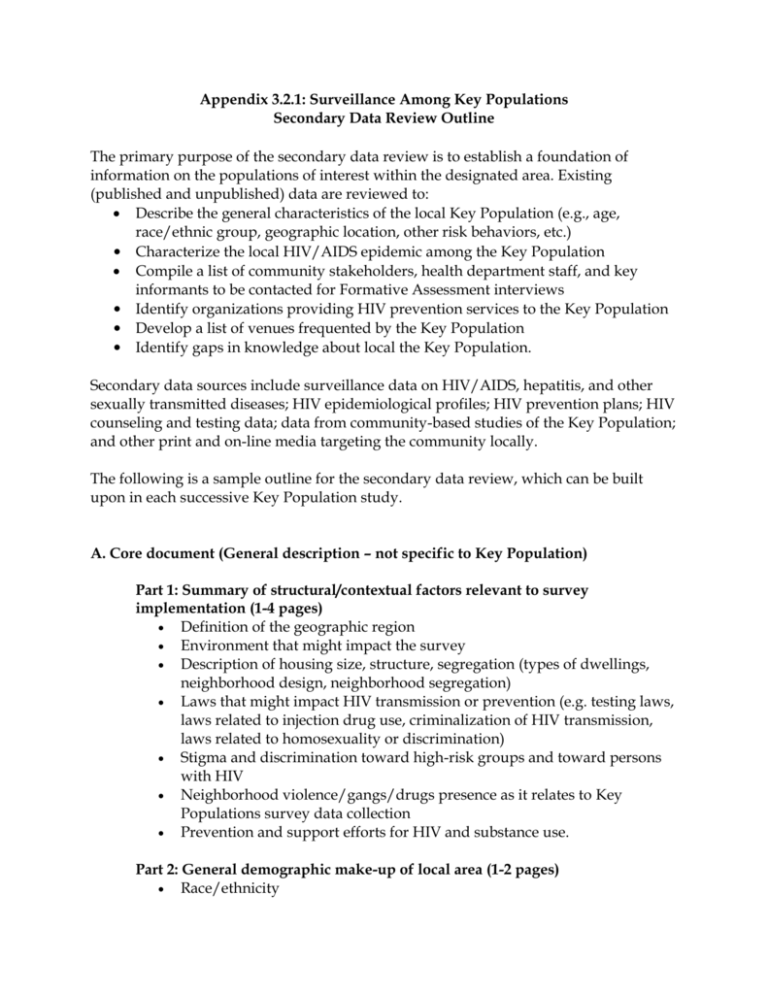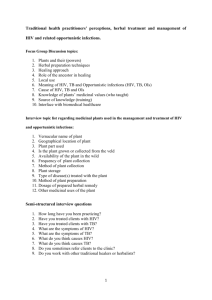Secondary Data Review
advertisement

Appendix 3.2.1: Surveillance Among Key Populations Secondary Data Review Outline The primary purpose of the secondary data review is to establish a foundation of information on the populations of interest within the designated area. Existing (published and unpublished) data are reviewed to: Describe the general characteristics of the local Key Population (e.g., age, race/ethnic group, geographic location, other risk behaviors, etc.) • Characterize the local HIV/AIDS epidemic among the Key Population Compile a list of community stakeholders, health department staff, and key informants to be contacted for Formative Assessment interviews • Identify organizations providing HIV prevention services to the Key Population • Develop a list of venues frequented by the Key Population • Identify gaps in knowledge about local the Key Population. Secondary data sources include surveillance data on HIV/AIDS, hepatitis, and other sexually transmitted diseases; HIV epidemiological profiles; HIV prevention plans; HIV counseling and testing data; data from community-based studies of the Key Population; and other print and on-line media targeting the community locally. The following is a sample outline for the secondary data review, which can be built upon in each successive Key Population study. A. Core document (General description – not specific to Key Population) Part 1: Summary of structural/contextual factors relevant to survey implementation (1-4 pages) Definition of the geographic region Environment that might impact the survey Description of housing size, structure, segregation (types of dwellings, neighborhood design, neighborhood segregation) Laws that might impact HIV transmission or prevention (e.g. testing laws, laws related to injection drug use, criminalization of HIV transmission, laws related to homosexuality or discrimination) Stigma and discrimination toward high-risk groups and toward persons with HIV Neighborhood violence/gangs/drugs presence as it relates to Key Populations survey data collection Prevention and support efforts for HIV and substance use. Part 2: General demographic make-up of local area (1-2 pages) Race/ethnicity Age groups Highest level of education attained Annual household income Percentage of residents living below poverty line Health insurance coverage Unemployment Part 3: Demographic characteristics of persons diagnosed with HIV in the area – interpret/present data to enhance Key Populations survey (1-2 pages) Race/ethnicity Age groups Country of birth Mode of transmission Geographic B. Key Population-specific document Part 1: Overview of HIV diagnoses in target Key Population (1 page) Race/ethnicity Age groups Country of birth Mode of transmission Geographic Part 2: Summary of sociodemographic characteristics of target Key Population (from earlier Key Populations survey cycles and/or other local studies) and comparison to Part 1 (1-2 pages) Race/ethnicity Age groups Country of birth Mode of transmission Geographic Part 3: Summary of relevant research (2-4 pages) Summary of relevant studies conducted among the Key Population, and other relevant information with an emphasis on HIV risk behaviors, social networks, sub-populations, geographic concentrations of population in specific areas. • How is the Key Population defined? • Are there noted sub-populations? • Are there key locations/environments where the sub-populations can be reached? • Are there specific NGOs and/or clinics that the population or suppopulation is more likely to frequent? • Are there existing and reliable data sources that track behaviors and/or HIV and/or STD prevalence in the population? • What is the uptake of HIV screening or STD screening among the Key Population? Part 4: Formative Assessment Data Plan (1-2 pages) A brief summary of the major findings of the secondary review process: A summary of the topics and populations that Key Populations survey staff need to learn more about during the formative assessment in order to efficiently implement the survey Goal and objectives for the Formative Assessment Explanation of how data will be collected Designation of responsibility for each research activity Timeline Interview guides




